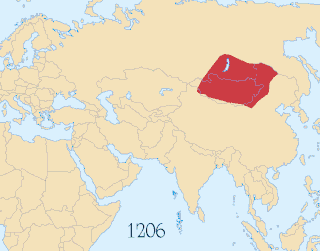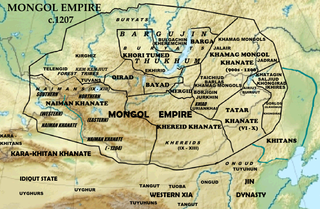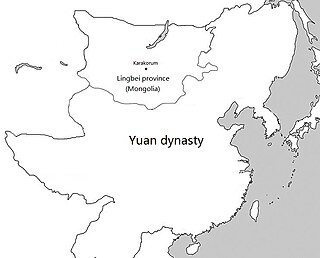
The Mongol Empire of the 13th and 14th centuries was the largest contiguous empire in history. Originating in present-day Mongolia in East Asia, the Mongol Empire at its height stretched from the Sea of Japan to parts of Eastern Europe, extending northward into parts of the Arctic; eastward and southward into parts of the Indian subcontinent, mounted invasions of Southeast Asia, and conquered the Iranian Plateau; and reached westward as far as the Levant and the Carpathian Mountains.

Töregene Khatun was the Great Khatun and regent of the Mongol Empire from the death of her husband Ögedei Khan in 1241 until the election of her eldest son Güyük Khan in 1246.

Öljeyitü Khan, born Temür, also known by his temple name as the Emperor Chengzong of Yuan, was the second emperor of the Yuan dynasty of China, ruling from May 10, 1294 to February 10, 1307. Apart from being the Emperor of China, he is considered as the sixth Great Khan of the Mongol Empire, although it was only nominal due to the division of the empire. He was an able ruler of the Yuan dynasty, and his reign established the patterns of power for the next few decades.

A Borjigin is a member of the Mongol sub-clan that started with Bodonchar Munkhag of the Kiyat clan. Yesugei's descendants were thus said to be Kiyat-Borjigin. The senior Borjigids provided ruling princes for Mongolia and Inner Mongolia until the 20th century. The clan formed the ruling class among the Mongols and some other peoples of Central Asia and Eastern Europe. Today, the Borjigid are found in most of Mongolia, Inner Mongolia and Xinjiang, and genetic research has shown that descent from Genghis Khan and Timur is common throughout Central Asia and other regions.

Drogön Chogyal Phagpa, was the fifth leader of the Sakya school of Tibetan Buddhism. He was also the first Imperial Preceptor of the Yuan dynasty and was concurrently named the director of the Bureau of Buddhist and Tibetan Affairs, serving during the reign of Kublai Khan.

Ariq Böke, the components of his name also spelled Arigh, Arik and Bukha, Buka, was the seventh and youngest son of Tolui and a grandson of Genghis Khan. After the death of his brother the Great Khan Möngke, Ariq Böke claimed the title of the Great Khan of the Mongol Empire and briefly took power while his brothers Kublai and Hulagu were absent from the Mongolian Plateau. When Kublai returned for an election in 1260, rival factions could not agree, and elected both claimants, Kublai and Ariq Böke, to the throne, resulting in the Toluid Civil War that fragmented the Mongol Empire. Ariq Böke was supported by the traditionalists of the Mongol Empire, while his brother Kublai was supported by the senior princes of North China and Manchuria.

Kaidu was a grandson of the Mongol khagan Ögedei (1185–1241) and thus leader of the House of Ögedei and the de facto khan of the Chagatai Khanate, a division of the Mongol Empire. He ruled parts of modern-day Xinjiang and Central Asia during the 13th century, and actively opposed his uncle, Kublai, who established the Yuan dynasty. Medieval chroniclers often mistranslated Kadan as Kaidu, mistakenly placing Kaidu at the Battle of Legnica. Kadan was the brother of Güyük, and Kaidu's uncle.
Khasar, was one of the three full brothers of the legend Genghis Khan. According to the Jami' al-Tawarikh, his given name was Jochi and he got the nickname Khasar after his distinguished bravery. He was also called Khabht Khasar because he was skilled with a bow.
Bayan of the Baarin, or Boyan, was an ethnic Mongol general of the Yuan dynasty of China. He was known to Marco Polo as "Bayan Hundred Eyes". He commanded the army of Kublai Khan against the Southern Song dynasty, ushering in the Southern Song collapse and the conquest of southern China by the Yuan dynasty.

The Yuan dynasty, officially the Great Yuan, was a Mongol-led imperial dynasty of China and a successor state to the Mongol Empire after its division. It was established by Kublai, the fifth khagan-emperor of the Mongol Empire from the Borjigin clan, and lasted from 1271 to 1368. In Chinese history, the Yuan dynasty followed the Song dynasty and preceded the Ming dynasty.

Kublai Khan, also known by his temple name as the Emperor Shizu of Yuan and his regnal name Setsen Khan, was the founder and first emperor of the Mongol-led Yuan dynasty of China. He proclaimed the dynastic name "Great Yuan" in 1271, and ruled Yuan China until his death in 1294.

Kheshig were the imperial guard and shock troops for Mongol royalty in the Mongol Empire, particularly for rulers like Genghis Khan and his wife Börte. Their primary purpose was to act as bodyguards for the emperors and other important nobles. They were divided into two groups: the day guard (Torguud) and the night guard (Khevtuul). They were distinct from the regular army and would not go to battle with them, instead staying back on guard duty. Their supreme commander was called the Cherbi.
The Yuan dynasty (1271–1368) was a dynasty of China ruled by the Mongol Borjigin clan. Founded by Kublai Khan, it is considered one of the successors to the Mongol Empire.

Marco Polo is an American drama television series inspired by Marco Polo's early years in the court of Kublai Khan, the Khagan of the Mongol Empire and the founder of the Yuan dynasty (1271–1368). The show premiered on Netflix on December 12, 2014. The series was created by John Fusco and stars Lorenzo Richelmy in the title role, with Benedict Wong as Kublai Khan. It was produced by The Weinstein Company. On January 7, 2015, Marco Polo was renewed by Netflix for a 10-episode second season, which premiered on July 1, 2016.
The division of the Mongol Empire began after Möngke Khan died in 1259 in the siege of Diaoyu Castle with no declared successor, precipitating infighting between members of the Tolui family line for the title of khagan that escalated into the Toluid Civil War. This civil war, along with the Berke–Hulagu war and the subsequent Kaidu–Kublai war, greatly weakened the authority of the great khan over the entirety of the Mongol Empire, and the empire fractured into four khanates: the Golden Horde in Eastern Europe, the Chagatai Khanate in Central Asia, the Ilkhanate in Iran, and the Yuan dynasty in China based in modern-day Beijing – although the Yuan emperors held the nominal title of khagan of the empire.

The Yuan dynasty in Inner Asia was the domination of the Yuan dynasty in Inner Asia in the 13th and the 14th centuries. The Borjigin rulers of the Yuan came from the Mongolian steppe, and the Mongols under Kublai Khan established the Yuan dynasty (1271–1368) based in Khanbaliq. The Yuan was a dynasty that incorporated many aspects of Mongol and Chinese political and military institutions.

Manchuria under Yuan rule refers to the Yuan dynasty's rule over Manchuria, corresponding to modern Manchuria and Outer Manchuria, from 1271 to 1368. Mongol rule over Manchuria was established after the Mongol Empire's conquest of the Jin dynasty and the Eastern Xia dynasty in the early 13th century. It became a part of the Yuan dynasty of China led by Kublai Khan in 1271. During the Yuan, it was administered as Liaoyang province. Even after the overthrow of the Yuan dynasty by the Ming dynasty in 1368, Manchuria was still controlled by the Northern Yuan dynasty for almost 20 years, until it was conquered by the Ming during its campaign against Naghachu and put under Ming rule.

The Yuan dynasty ruled over the Mongolian Plateau, including both Inner and Outer Mongolia as well as part of southern Siberia, between 1271 and 1368. The Mongolian Plateau is where the ruling Mongol Borjigin clan of the Yuan dynasty came from, thus it enjoyed a somewhat special status during the Yuan dynasty, although the capital of the dynasty had been moved from Karakorum to Khanbaliq since the beginning of Kublai Khan's reign, and Mongolia had been converted into a regular province, known as the Lingbei Province, by the early 14th century.
Shiregi was a Mongol prince from the Borjigin clan, great-grandson of Genghis Khan.
Manggala was a prince of the Mongol-led Chinese Yuan dynasty. He was a son of the Yuan founding emperor Kublai Khan.














